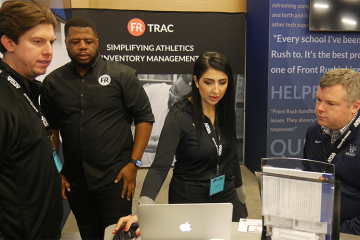The recruiting process can be a foreign language to high school athletes, so our partner NCSA teamed up with USA TODAY to deliver a weekly column on the college recruiting process. Student athletes get practical tips and real-world advice on becoming a better recruit to maximize opportunities to play at the college level.

Mike Thrower, Front Rush’s director of product, gives USA TODAY an insider’s perspective on how coaches recruit players and decide who gets an offer. Thrower has worked in elite college athletics for more than 20 years.
Athletes gunning for a place on a college roster should brush up on how coaches recruit players and decide who gets an offer. Coaches might find value in sharing articles like this on Twitter for potential recruits to see and learn from.
“Simply put, a recruiting board is a huge, ranked list of recruits the coach is interested in. The higher priority athletes will be toward the top, and the prospects they still aren’t sure about will be toward the bottom. Thrower points out that, the larger the roster size, the more important a recruiting board will be. For example, in football, recruiting boards are incredibly helpful, as coaches might be seriously recruiting 10-20 quarterbacks, dozens of linemen, and so on.”
All coaches recruit differently. But, there are trends that athletes should know about. Thrower explains that the sophomore year/the summer before junior year, evaluation periods during junior year, summer before senior year and senior year are when big shifts in recruiting boards tend to happen.
Thrower has been working with Front Rush to develop digital recruit boards that are customizable for each coach’s process. New additions to the recruit boards include stickers that allow coaches to visually “tag” players. These stickers can indicate recruits with good or bad grades and other key signifiers. Stickers appear next to the athlete on their profile and on their board cards in Front Rush’s ELITE coach software.
“Thrower also emphasizes that a recruit’s grades can make a big impact on their position on a coach’s recruiting board. In most cases, coaches just don’t want to take a chance on an athlete who’s a poor student in high school, because they run the risk that the athlete won’t be able to stay academically eligible in college. He also says, ‘All else being equal, every college will recruit the kid with the better grades! The better your grades the better your offers.’”
Sharing articles like NCSA’s column is a helpful way to improve the recruiting process and increase potential recruits’ knowledge.
“Thrower says, ‘This is how the average recruiting board works, but some programs out there will be offering 8th graders. Some programs know that they are a second-tier team, so they wait for the top-tier schools to finish their recruiting and see which kids didn’t get picked up.’ Use these general guidelines to better inform your recruiting journey, so you can get the results you want.”




